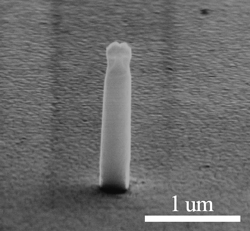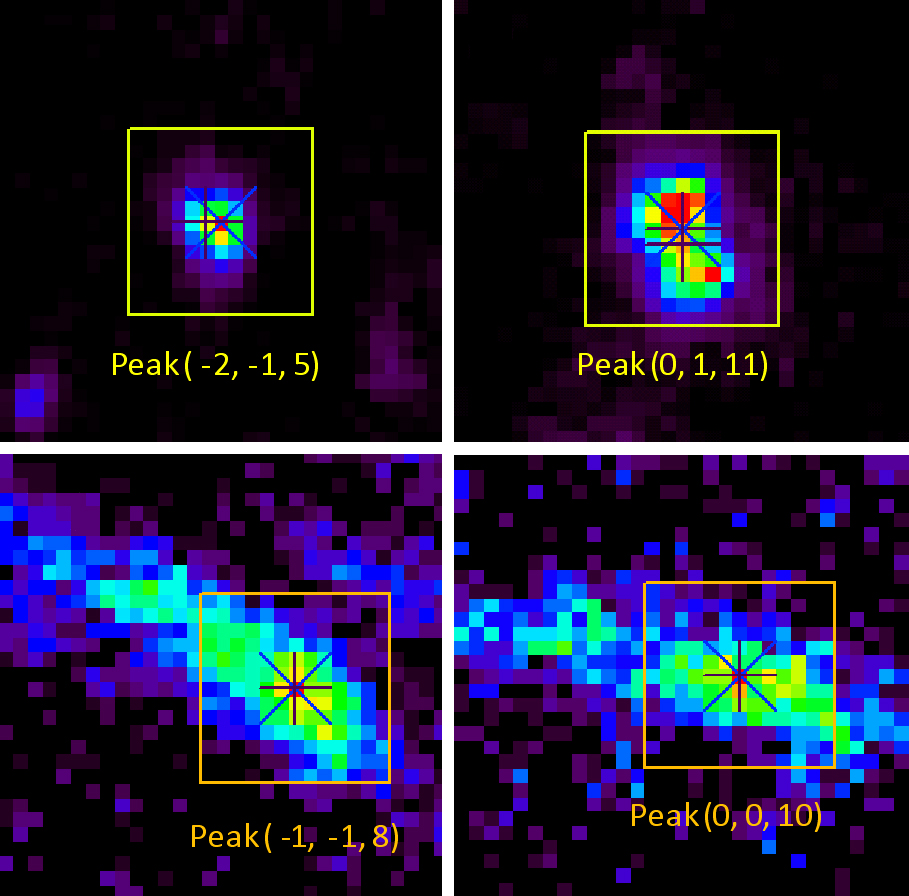
Indium is a key material in lead-free solder applications for microelectronics due to its excellent wetting properties, extended ductility, and high electrical conductivity. With the size of electronic devices continuing to shrink and the promise of indium-based nanotechnologies, it is important to develop a fundamental understanding of this material’s small-scale mechanical properties and reliability. Researchers from the University of Waterloo, California Institute of Technology, and Los Alamos National Laboratory have collaborated with a team at ALS Beamline 12.3.2 to investigate the small-scale mechanics of indium nanostructures. Scanning x-ray microdiffraction (μSXRD) studies revealed that the indium microstructure is typical of a well-annealed metal, containing very few initial dislocations and showing close-to-theoretical strength.
Metallic nanopillars suitable for mechanical testing were fabricated by lithographic patterning of a polymethylmethacrylate (PMMA) resist with electron-beam lithography, followed by selective metal electroplating into the resist template. This approach is advantageous for low-melting-temperature materials such as indium, since conventional pillar fabrication by focused ion-beam milling techniques ultimately leads to melting or structural degradation. All indium nanopillar samples were annealed at room temperature for about 30 days prior to mechanical testing. Uniaxial compression tests of the indium nanopillars were performed in a nanoindenter equipped with a flat-punch diamond tip.
Under compressive loads, the average nanopillar yield stress and ultimate strength were determined to be 181 ± 77 MPa and 606 ± 112 MPa, respectively. These values correspond to about 1/28 and 1/7 of the bulk indium shear modulus (G = 4.35 GPa), that is, approaching the metal’s theoretical strength. This finding is quite remarkable since indium is generally considered a soft metal, yet it exhibits exceptional mechanical strength at the nanoscale. To develop a deeper understanding of the origins of high strength in this material at the nanoscale, proper evaluation of the post-experimental microstructure is required. However, conventional structural characterization methods such as electron backscattered diffraction and transmission electron microcopy result in localized joule heating, leading to the activation of thermally assisted processes like dislocation climb, defect annihilations, grain growth, deformation, and even melting in these low-temperature metals. Utilizing nondestructive μSXRD is, therefore, the best choice for assessing the formed microstructure. This method uses a focused polychromatic x-ray beam to obtain Laue diffraction patterns of the indium pillars, which, in turn, can be used to determine the grain orientations, local residual stresses and strains, and dislocation densities.

Two distinct indexations of the Laue diffraction patterns collected for a particular indium nanopillar revealed that it consisted of two grains with out-of-plane orientations. The diffraction spots from each grain had similar intensities, suggesting the grains were comparable in size. Dislocation structures within these two crystals were determined by analyzing the shape of the Laue diffraction spots. The circular intensity pattern surrounding the spots for the first grain indicated a fully annealed crystal with no excess geometrically necessary dislocations (GNDs). In contrast, the spots generated from the second grain have a Laue spot streak subtending an arc of about 1.2°. This suggests nonuniform plastic deformation induced either by the fabrication process or by the initial presence of GNDs. The initial density of GNDs in this grain was estimated to be 3.35 x 109 cm-2 (Cahn-Nye analysis), which translates into about 4.2 total dislocations in a 250-nm-diameter nanopillar.
These results show that the use of μSXRD as a nondestructive microstructural characterization technique helped establish a physical link between the observed nanomechanical behavior of indium nanopillars and their initial microstructure. These findings greatly extend our understanding of mechanical deformation in nanoscale solid materials and further demonstrate the broad applications of scanning x-ray microdiffraction technique in scientific discovery.

Contact: Ting Tsui
Research conducted by G. Lee, M.J. Burek, and T.Y. Tsui (University of Waterloo); J.Y. Kim and J.R. Greer (California Institute of Technology); A.S. Budiman (Los Alamos National Laboratory); and N. Tamura, M. Kunz, and K. Chen (ALS).
Research funding: Natural Sciences and Engineering Research Council of Canada, University of Waterloo, and Los Alamos National Laboratory. Operation of the ALS is supported by the U.S. Department of Energy (DOE), Office of Basic Energy Sciences.
Publication about this research: G. Lee, J.Y. Kim, A.S. Budiman, N. Tamura, M. Kunz, K. Chen, M.J. Burek, J.R. Greer, and T.Y. Tsui, “Fabrication, structure and mechanical properties of indium nanopillars,” Acta Mater. 58, 1361 (2010). doi:10.1016/j.actamat.2009.10.042
SCIENCE HIGHLIGHT #210